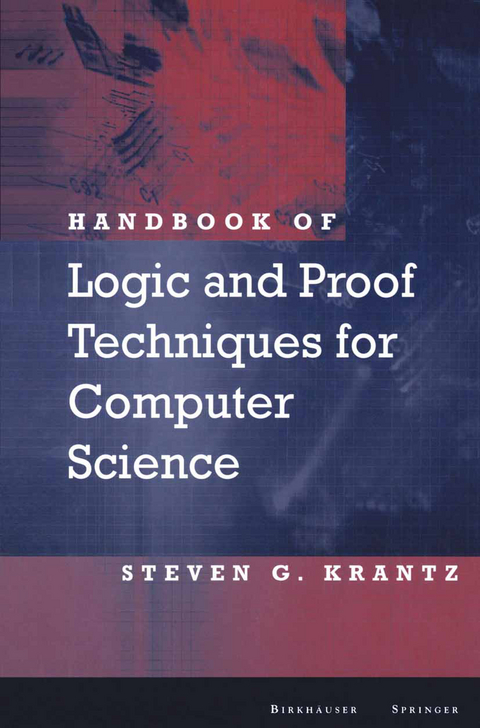
Handbook of Logic and Proof Techniques for Computer Science
Birkhauser Boston Inc (Verlag)
978-0-8176-4220-4 (ISBN)
Logic is, and should be, the core subject area of modern mathemat ics. The blueprint for twentieth century mathematical thought, thanks to Hilbert and Bourbaki, is the axiomatic development of the subject. As a result, logic plays a central conceptual role. At the same time, mathematical logic has grown into one of the most recondite areas of mathematics. Most of modern logic is inaccessible to all but the special ist. Yet there is a need for many mathematical scientists-not just those engaged in mathematical research-to become conversant with the key ideas of logic. The Handbook of Mathematical Logic, edited by Jon Bar wise, is in point of fact a handbook written by logicians for other mathe maticians. It was, at the time of its writing, encyclopedic, authoritative, and up-to-the-moment. But it was, and remains, a comprehensive and authoritative book for the cognoscenti. The encyclopedic Handbook of Logic in Computer Science by Abramsky, Gabbay, and Maibaum is a wonderful resource for the professional. But it is overwhelming for the casual user. There is need for a book that introduces important logic terminology and concepts to the working mathematical scientist who has only a passing acquaintance with logic. Thus the present work has a different target audience. The intent of this handbook is to present the elements of modern logic, including many current topics, to the reader having only basic mathe matical literacy.
1 Notation and First-Order Logic.- 1.1 The Use of Connectives.- 1.2 Truth Values and Truth Tables.- 1.3 The Use of Quantifiers.- 1.4 Gödel’s Completeness Theorem.- 1.5 Second-Order Logic.- 2 Semantics and Syntax.- 2.1 Elementary Symbols.- 2.2 Well-Formed Formulas or wffs [Syntax].- 2.3 Free and Bound Variables (Syntax).- 2.4 The Semantics of First-Order Logic.- 3 Axiomatics and Formalism in Mathematics.- 3.1 Basic Elements.- 3.2 Models.- 3.3 Consistency.- 3.4 Gödel’s Incompleteness Theorem.- 3.5 Decidability and Undecidability.- 3.6 Independence.- 4 The Axioms of Set Theory.- 4.1 Introduction.- 4.2 Axioms and Discussion.- 4.3 Concluding Remarks.- 5 Elementary Set Theory.- 5.1 Set Notation.- 5.2 Sets, Subsets, and Elements.- 5.3 Binary Operations on Sets.- 5.4 Relations and Equivalence Relation.- 5.5 Equivalence Relations.- 5.6 Number Systems.- 5.7 Functions.- 5.8 Cardinal Numbers.- 5.9 A Word About Classes.- 5.10 Fuzzy Set Theory.- 5.11 The Lambda Calculus.- 5.12 Sequences.- 5.13 Bags.- 6 Recursive Functions.- 6.1 Introductory Remarks.- 6.2 Primitive Recursive Functions.- 6.3 General Recursive Functions.- 7 The Number Systems.- 7.1 The Natural Numbers.- 7.2 The Integers.- 7.3 The Rational Numbers.- 7.4 The Real Numbers.- 7.5 The Complex Numbers.- 7.6 The Quaternions.- 7.7 The Cayley Numbers.- 7.8 Nonstandard Analysis.- 8 Methods of Mathematical Proof.- 8.1 Axiomatics.- 8.2 Proof by Induction.- 8.3 Proof by Contradiction.- 8.4 Direct Proof.- 8.5 Other Methods of Proof.- 9 The Axiom of Choice.- 9.1 Enunciation of the Axiom.- 9.2 Examples of the Use of the Axiom of Choice.- 9.3 Consequences of the Axiom of Choice.- 9.4 Paradoxes.- 9.5 The Countable Axiom of Choice.- 9.6 Consistency of the Axiom of Choice.- 9.7 Independence of the Axiom of Choice.- 10 Proof Theory.-10.1 General Remarks.- 10.2 Cut Elimination.- 10.3 Propositional Resolution.- 10.4 Interpolation.- 10.5 Finite Type.- 10.6 Beth’s Definability Theorem.- 11 Category Theory.- 11.1 Introductory Remarks.- 11.2 Metacategories and Categories.- 12 Complexity Theory.- 12.1 Preliminary Remarks.- 12.2 Polynomial Complexity.- 12.3 Exponential Complexity.- 12.4 Two Tables for Complexity Theory.- 12.5 Problems of Class P.- 12.6 Problems of Class NP.- 12.7 NP-Completeness.- 12.8 Cook’s Theorem.- 12.9 Examples of NP-Complete Problems.- 12.10 More on P/NP.- 12.11 Descriptive Complexity Theory.- 13 Boolean Algebra.- 13.1 Description of Boolean Algebra.- 13.2 Axioms of Boolean Algebra.- 13.3 Theorems in Boolean Algebra.- 13.4 Illustration of the Use of Boolean Logic.- 14 The Word Problem.- 14.1 Introductory Remarks.- 14.2 What Is a Group?.- 14.3 What Is a Free Group?.- 14.4 The Word Problem.- 14.5 Relations and Generators.- 14.6 Amalgams.- 14.7 Description of the Word Problem.- List of Notation from Logic.- Glossary of Terms from Mathematical and Sentential Logic.- A Guide to the Literature.
| Zusatzinfo | XIX, 245 p. |
|---|---|
| Verlagsort | Secaucus |
| Sprache | englisch |
| Maße | 155 x 235 mm |
| Themenwelt | Mathematik / Informatik ► Informatik ► Theorie / Studium |
| Mathematik / Informatik ► Mathematik ► Angewandte Mathematik | |
| Mathematik / Informatik ► Mathematik ► Logik / Mengenlehre | |
| Schlagworte | Computation Theory • Formal Languages • Math Logic • Proof methods |
| ISBN-10 | 0-8176-4220-X / 081764220X |
| ISBN-13 | 978-0-8176-4220-4 / 9780817642204 |
| Zustand | Neuware |
| Haben Sie eine Frage zum Produkt? |
aus dem Bereich


